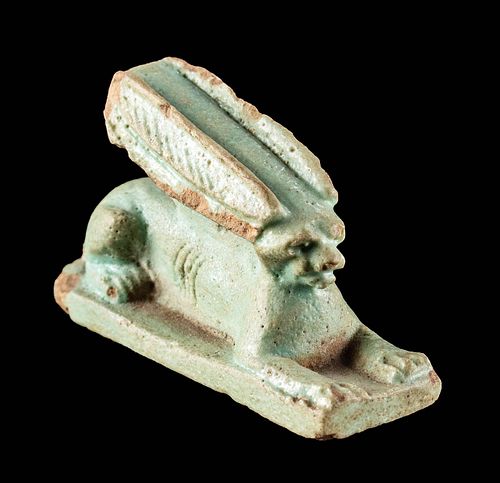Egyptian Ptolemaic Faience Couchant Desert Hare Pendant
Lot 4
About Seller
Artemis Fine Arts
686 S Taylor Ave, Ste 106
Louisville, CO 80027
United States
Selling antiquities, ancient and ethnographic art online since 1993, Artemis Gallery specializes in Classical Antiquities (Egyptian, Greek, Roman, Near Eastern), Asian, Pre-Columbian, African / Tribal / Oceanographic art. Our extensive inventory includes pottery, stone, metal, wood, glass and textil...Read more
Estimate:
$1,500 - $2,250
Absentee vs Live bid
Two ways to bid:
- Leave a max absentee bid and the platform will bid on your behalf up to your maximum bid during the live auction.
- Bid live during the auction and your bids will be submitted real-time to the auctioneer.
Bid Increments
| Price | Bid Increment |
|---|---|
| $0 | $25 |
| $300 | $50 |
| $1,000 | $100 |
| $2,000 | $250 |
| $5,000 | $500 |
| $10,000 | $1,000 |
| $20,000 | $2,500 |
| $50,000 | $5,000 |
| $100,000 | $10,000 |
| $200,000 | $20,000 |
About Auction
By Artemis Fine Arts
Oct 21, 2021
Set Reminder
2021-10-21 10:00:00
2021-10-21 10:00:00
America/New_York
Bidsquare
Bidsquare : Fall Antiquities & Ethnographic Art Auction
https://www.bidsquare.com/auctions/artemis-gallery/fall-antiquities-ethnographic-art-auction-7725
Ancient art from Egypt, Greece, Italy and the Near East, as well as Asian, Fossils, Pre-Columbian, Native American, African / Tribal / Oceanic, Fine art, and much more! All categories, all price ranges... all legally acquired and guaranteed to be as described or your money back. Artemis Fine Arts info@artemisfinearts.com
Ancient art from Egypt, Greece, Italy and the Near East, as well as Asian, Fossils, Pre-Columbian, Native American, African / Tribal / Oceanic, Fine art, and much more! All categories, all price ranges... all legally acquired and guaranteed to be as described or your money back. Artemis Fine Arts info@artemisfinearts.com
- Lot Description
Egypt, Ptolemaic Period, ca. 332 to 30 BCE. A mold-formed pendant of a desert hare covered in pale blue-green glaze. The hare lays couchant atop an integral plinth with its forelegs extended in front of its streamlined body, its back legs tucked beneath its haunches, and a petite tail protruding off the verso. Its head is raised in attention, with a gaunt face bearing beady eyes and bulging jowls, and an enormous pair of furry ears swept back atop almost the entire body; a suspension hole is drilled laterally beneath the ears. Size: 1.9" L x 0.65" W x 1.125" H (4.8 cm x 1.7 cm x 2.9 cm)
The desert hare was a fascinating creature within the Egyptian ecosystem. According to Egyptologist Dorothea Arnold, "Among the small animals of the Egyptian desert is the desert hare, Lepus capensis. In ancient times it was not considered worthy prey for princely hunters, and in representations it appears only occasionally among the spoils of the hunt. In many hunting scenes, however, it can be found in the background as part of the landscape. The tomb relief of Ra-m-kaj, for example, includes a desert hare in much the same position as the one that forms this amulet. It crouches low to the ground, ears flattened, intent on eluding the hunter's notice. The desert hare's sand-colored fur . . . serves it well as camouflage. If detected, however, the hare uses its great speed to help it escape. The hare's amuletic role is not known for certain. Ancient Greek and Roman authors believed that hares could sleep with their eyes open and reproduce without copulation. If these were also Egyptian beliefs, the hare might have represented extreme vigilance or the primeval deity's self-creating power." (Arnold, Dorothea. "An Egyptian Bestiary." The Metropolitan Museum of Art Bulletin, Spring 1995, Vol. LII, no. 4, p. 23)
Cf. The Metropolitan Museum of Art, accession number 74.51.4505
Provenance: private Toronto, Ontario, Canada collection, by descent, acquired in Egypt in 1894 to 1896
All items legal to buy/sell under U.S. Statute covering cultural patrimony Code 2600, CHAPTER 14, and are guaranteed to be as described or your money back.
A Certificate of Authenticity will accompany all winning bids.
PLEASE NOTE: Due to recent increases of shipments being seized by Australian & German customs (even for items with pre-UNESCO provenance), we will no longer ship most antiquities and ancient Chinese art to Australia & Germany. For categories of items that are acceptable to ship to Australia or Germany, please contact us directly or work with your local customs brokerage firm.
Display stands not described as included/custom in the item description are for photography purposes only and will not be included with the item upon shipping.
#167186Chips to plinth, tail, and both ears, with softening to some finer details around face and incised ribs, minor pitting, and light fading to glaze pigment. Nice preservation to overall form and glaze pigment.Condition
- Shipping Info
-
All shipping is handled in-house for your convenience. Your invoice from Artemis Gallery will include shipping calculation instructions. If in doubt, please inquire BEFORE bidding for estimated shipping costs for individual items.
-
- Buyer's Premium



 EUR
EUR CAD
CAD AUD
AUD GBP
GBP MXN
MXN HKD
HKD CNY
CNY MYR
MYR SEK
SEK SGD
SGD CHF
CHF THB
THB











